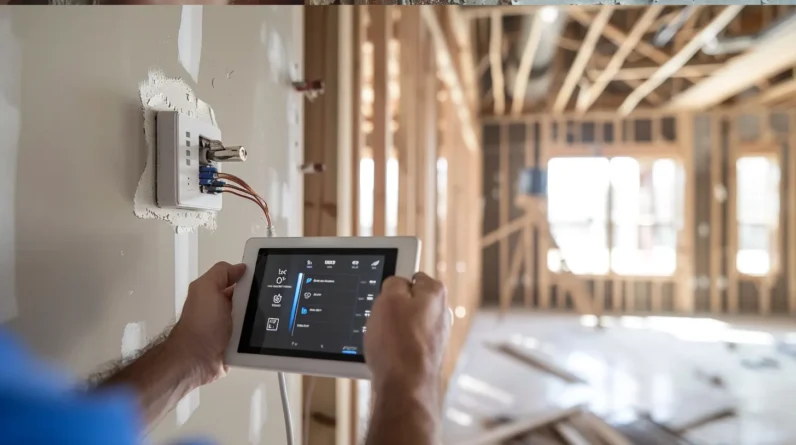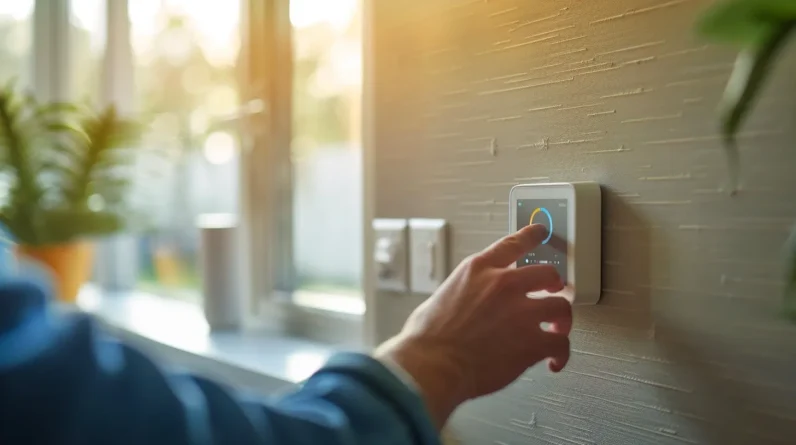
Smart thermostats guarantee family comfort while boosting savings. They efficiently manage temperatures, adapt to routines, and offer remote adjustments. These devices ensure personalized comfort, reduce costs with smart algorithms, and integrate seamlessly with your smart home setup. By monitoring energy use, offering insights, and practicing eco-friendly habits, they revolutionize your HVAC system’s efficiency. Look further into detailed features for a thorough understanding of how smart thermostats can optimize your home environment and finances.
Energy-Efficient Temperature Control
When establishing energy-efficient temperature control on smart thermostats, we prioritize optimizing comfort while maximizing savings through precise scheduling and temperature adjustments.
By setting up a tailored schedule that aligns with occupancy patterns and personal preferences, we guarantee that heating and cooling systems operate at peak efficiency. Smart thermostats utilize advanced algorithms to learn household routines, adjusting temperatures accordingly to avoid unnecessary energy consumption.
Through remote access features, users can monitor and modify settings from anywhere, ensuring comfort upon arrival while conserving energy when away. Moreover, the incorporation of occupancy sensors enables automatic adjustments based on room activity, further enhancing energy efficiency.
These strategic approaches not only boost comfort levels but also contribute significantly to long-term cost savings.
Personalized Comfort Settings
To optimize personalized comfort settings on smart thermostats, we tailor temperature controls to individual preferences and occupancy behaviors, ensuring an ideal environment while maximizing energy efficiency. By customizing these settings, we can provide a tailored heating and cooling experience that meets the unique needs of each family member.
Here are four key strategies we employ to achieve personalized comfort settings:
1. Occupancy Sensors: We utilize occupancy sensors to detect when rooms are in use, adjusting the temperature accordingly.
2. Learning Algorithms: Smart thermostats learn user habits over time, adapting settings to individual preferences.
3. Remote Access: Users can control the thermostat remotely, ensuring comfort upon arrival home.
4. Zone Control: Dividing the house into zones allows for different temperatures in various areas, catering to specific comfort requirements.
Cost-Saving Features
Utilizing advanced algorithms and energy-saving features, smart thermostats offer cost-effective solutions for efficient temperature management in households. These devices analyze usage patterns and adjust heating and cooling settings automatically to optimize energy consumption.
By learning the household’s schedule and occupancy habits, smart thermostats can adjust temperatures accordingly, ensuring comfort when needed and conserving energy when the house is empty. Moreover, features like geofencing allow the thermostat to detect when residents are away and adjust settings to save energy.
Some models even provide energy reports, detailing usage patterns and offering insights for further savings. Overall, these cost-saving features not only promote energy efficiency but also contribute to reducing utility bills over time.
Remote Access and Control
With smart thermostats, users can remotely access and control their home’s temperature settings, providing convenience and flexibility in managing comfort levels efficiently. This feature allows for adjustments from anywhere with an internet connection, optimizing energy usage and ensuring a comfortable environment upon arrival.
1. Real-time Monitoring: Users can check and adjust their home’s temperature settings in real-time.
2. Scheduling Flexibility: Customizable schedules enable precise temperature control based on daily routines.
3. Energy Savings: Remote access helps in reducing energy waste by adjusting settings when away.
4. Temperature Alerts: Receive notifications for extreme temperature changes, ensuring prompt action to maintain comfort and efficiency.
Learning and Adaptive Technology
Our experience with smart thermostats has revealed the significant capabilities of learning and adaptive technology in enhancing home comfort and energy efficiency. These thermostats utilize advanced algorithms to analyze household patterns and preferences, learning the best temperature settings for different times of the day.
By adapting to our schedules and behaviors, they guarantee that our home is always at the right temperature without unnecessary energy consumption. Through continuous monitoring and adjustments, smart thermostats can create personalized heating and cooling schedules, maximizing comfort while minimizing energy waste.
The ability to adapt to changing conditions and user inputs sets these devices apart, providing a level of convenience and efficiency that traditional thermostats can’t match. Overall, learning and adaptive technology play an important role in optimizing our home environment and reducing energy costs.
Integration With Smart Home Systems
Having optimized our home environment through the utilization of learning and adaptive technology with smart thermostats, the next step involves exploring their seamless integration with smart home systems.
When merging smart thermostats with smart home systems, there are key considerations to guarantee a cohesive and efficient setup:
1. Compatibility: Check if the smart thermostat is compatible with the existing smart home system to avoid compatibility issues.
2. Automation: Set up automated routines to synchronize the thermostat with other smart devices for enhanced convenience.
3. Remote Access: Enable remote access to the thermostat through the smart home system for control from anywhere.
4. Data Sharing: Ensure seamless data sharing between the thermostat and other smart devices to optimize energy usage and enhance overall comfort.
Usage Reports and Insights
Utilizing usage reports and insights from smart thermostats provides valuable data for optimizing energy efficiency and enhancing comfort levels in the home.
These reports offer detailed information on temperature patterns, system runtime, and energy consumption. By analyzing this data, users can identify trends, set personalized heating and cooling schedules, and make informed decisions to reduce energy waste.
Insights into peak usage times enable strategic adjustments to save on utility costs without compromising comfort. Furthermore, tracking historical data allows for long-term energy-saving strategies, such as adjusting settings based on seasonal variations.
Smart thermostats offer a detailed view of household energy usage, empowering users to fine-tune their HVAC systems for maximum efficiency and comfort.
Eco-Friendly Practices
Implementing eco-friendly practices with smart thermostats involves optimizing energy usage and reducing environmental impact through strategic heating and cooling management. By utilizing advanced features and precision control, families can effectively lower their carbon footprint and contribute to a greener future.
Here are four key eco-friendly practices worth exploring:
1. Temperature Scheduling: Set temperature schedules to match your family’s routine, optimizing comfort while minimizing energy consumption.
2. Energy Usage Monitoring: Track energy usage patterns and adjust settings accordingly to reduce waste and promote efficiency.
3. Weather Adaptation: Utilize weather forecasts to proactively adjust thermostat settings, maximizing comfort without unnecessary energy consumption.
4. Remote Monitoring: Monitor and adjust thermostat settings remotely to prevent energy waste when away from home.
Maintenance and Support
With smart thermostats, regular maintenance and timely support are essential to guarantee peak performance and longevity of the system. It’s important to schedule routine check-ups to make sure that the thermostat is functioning at its best. This includes inspecting the connections, updating software, and calibrating the sensors.
In case of any issues, reaching out to technical support promptly can prevent minor problems from escalating. Familiarizing ourselves with the user manual can also aid in troubleshooting common issues efficiently. Moreover, staying informed about software updates and new features can maximize the thermostat’s capabilities.
Conclusion
To sum up, smart thermostats offer a range of benefits for enhancing family comfort and saving on energy costs. With advanced features like personalized settings, remote access, and adaptive technology, these devices provide a convenient and eco-friendly solution for temperature control.
According to a study by the US Department of Energy, smart thermostats can save homeowners an average of 10-12% on heating and 15% on cooling costs annually, making them a smart investment for any household.







